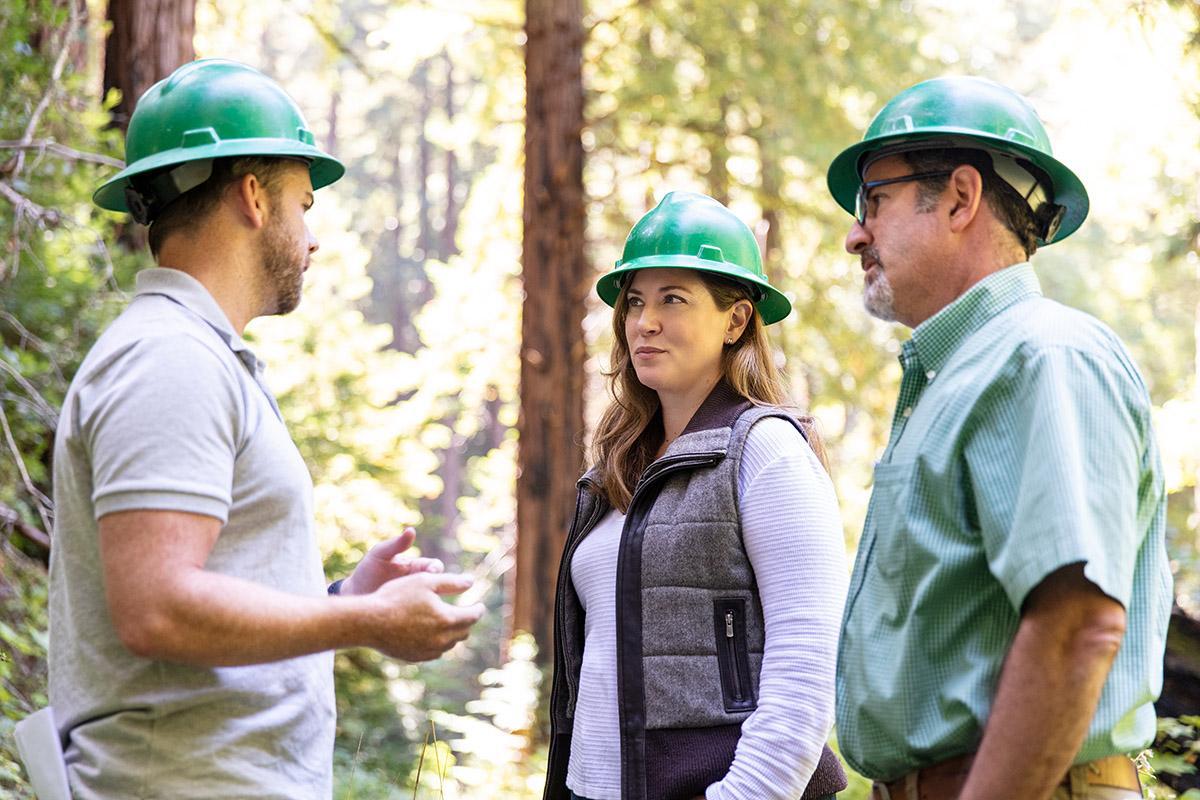
Ellen Jackowski, global head of sustainability strategy and innovation at HP, recently visited an FSC-certified forest to see responsible forest management in action.
Everyone has seen the messages on the wall near the office printer or at the end of an email: "Think before you print," "Please consider the environment before printing," or "Save paper, save a tree." These messages spring from the conventional wisdom that using paper requires trees, so avoiding printing must be the more environmentally friendly choice.
But what if printing could actually help protect and grow forests?
While deforestation is still occurring in some places around the world for paper production, companies that source or make paper can actually benefit the world’s forests, thanks to new developments in forestry practices and corporate commitments to conservation. When people buy paper and paper products that are sourced from well-managed forests, their purchases can protect forests instead of depleting them.
“As human beings, even if we do everything we can to reduce our consumption, we are still impacting the Earth’s natural environment,” says Ellen Jackowski, global head of sustainability strategy and innovation at HP. “We will always need to consume, but we must innovate to consume responsibly in harmony with our planet.”
HP currently makes all of its paper with fibers from sources that don't contribute to deforestation; the majority of HP paper around the world is certified to Forest Stewardship Council (FSC) standards, the gold standard in forest management that protects people and nature. That decision is part of a much bigger vision — a forest positive future, in which companies that source raw material from forests account for their impact by not only contributing to forest health today, but helping to preserve forests for the future.
Recently, HP has announced it is taking a huge leap forward to this future with longstanding partner and conservation leader World Wildlife Fund (WWF). Over the next five years, HP will contribute $11 million for WWF to restore part of Brazil's threatened Atlantic Forest and increase sustainable management of state-owned farms and forest plantations in China – ultimately protecting a combined area of 200,000 acres. HP’s partnership with WWF will support the development of science-based targets for forests, estimating carbon and nature co-benefits of forest restoration and improved forest management. The new initiative with WWF begins in November and marks the launch of HP’s Sustainable Forests Cooperative.
All HP-branded paper is already deforestation-free, and by 2020, the company is on track to achieve 100% zero-deforestation for all of its paper-based product packaging. These efforts and the partnership with WWF are supported by FSC and International Paper, one of the world’s largest paper manufacturers. The ultimate goal is to make printing with HP a catalyst for industry-wide support for FSC-certified and recycled fiber sourcing, while contributing to the restoration, protection, and improved management of the world’s forests.
Managing a healthy forest
Forests are essential to life on Earth. They provide homes for thousands of species. They produce oxygen, store carbon, and regulate global climate. And they support millions of people who depend on them for survival.
But along with clear-cutting for agriculture, demand for timber has fueled high rates of deforestation, threatening nearly half of the world’s forests. According to WWF, the planet is losing 18.7 million acres of forest each year — the equivalent of 27 soccer fields per minute. Recent fires in the Amazon rainforest and Indonesia and Africa have shown how the rate of deforestation has reached critical levels. Much of this is due to the fact that people cut the forest down to earn a living from things like soy or palm oil or beef. To counter this cycle, local communities need new ways to develop economically. By committing to purchasing FSC-certified fiber, HP is working to create incentives to keep forests intact and prevent deforestation.
Finding the balance of using and maintaining this precious resource that we can’t live without is crucial. On a recent visit to an FSC-certified forest near HP headquarters in northern California, HP’s Jackowski walked through a mix of young and old-growth redwoods. She saw streams where salmon swam, while birds chirped overhead. While this forest produces timber harvested for lumber, the visit gave a glimpse of what a sustainably managed forest can feel like.
“This is how the planet runs naturally and this is how we need to continue to protect it for future generations,” Jackowski says. “You can't eliminate certain aspects of a healthy forest and still expect it to maintain itself like it might have otherwise.”
Conventional forestry practices involve heavy harvesting and pesticide use. When chemicals are used, they can come into contact with freshwater bodies or local communities. But in an FSC-certified forest, trees are cut selectively and chemical use is highly restricted. Standards also cover the physical health, and social and economic well-being of people who work in FSC-certified forests.
“If you're walking in a conventionally managed forest, you're seeing very large openings and is a highly altered landscape,” says Corey Brinkema, president of FSC’s US national office. “Walking in an FSC-certified forest feels like you're walking in a natural forest. You tend to have the qualities that you would expect if you're walking through your state park.”
Conservation through collaboration
With the HP Sustainable Forests Cooperative, HP is taking steps to make printing with any paper more sustainable — not just its own. The new initiative is designed to conserve an area of forests and increase the supply of FSC fiber, enough to cover the amount of paper (even non-HP branded paper) that runs through HP printers, according to calculations by HP and WWF.
The initiative covers two forest conservation programs. One is a restoration project in Brazil’s Atlantic Forest, a biodiversity hotspot that’s home to jaguars, hundreds of tree species, and 5% of the Earth’s vertebrate species — many found nowhere else on Earth. The other will increase the area of responsibly managed forest in China, which produces and consumes more paper than any other country.
“HP wants to lead the way to help reduce negative impacts of printing with HP, and help educate consumers around sustainable paper choices that keep forests healthy," says Jackowski.
Every package of HP paper is sustainably sourced, carrying an FSC label, as have a number of products from companies that Brinkema says have followed HP’s lead. He says these commitments have been critical in creating demand for sustainably sourced paper, and that momentum has helped the network of certified forests grow.
FSC-certified forests must meet a strict set of standards, protecting biodiversity, wildlife, and the rights of indigenous and local communities through management methods that also consider soil, waterways, and vegetation. “Consumers can use their purchasing power to reward companies showing leadership for forests and nature,” says Linda Walker, senior director of corporate engagement for World Wildlife Fund. Looking for an FSC label “is the one simple action that people can take to know that they are helping forests with their purchasing decisions.”
For WWF, the new collaboration with HP is an opportunity to accelerate forest conservation in ways that can enhance existing efforts and influence other companies to step up, says Walker. In Brazil, for example, HP’s investment is adding to commitments by other companies, including supply-chain partner International Paper. International Paper manufactures HP-branded paper and produces seven million tons of responsibly sourced fiber for paper products each year.
This shared commitment is part of the forest positive concept, Walker says, ultimately strengthening forest health far into the future.
“You can have more of a likelihood of a resilient, connected landscape over time, versus more piecemeal conservation actions,” she says. “We believe this will have a lasting impact on forests and have a ripple effect on other companies that need to scale up their actions for forests. Every business is in the forest business, because every business depends either directly or indirectly on forests. For businesses to thrive in the future, nature needs to thrive.”
Image courtesy of HP
Previously published on HP's Garage Blog and the 3BL Media newsroom.

Learn more about how HP's Immersive Experiences Lab is creating innovative solutions for modern workers. And be sure to follow the Garage Blog here.














